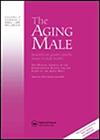Investigating the microbial pathogens of sexually transmitted infections among heterosexual Vietnamese men with symptomatic urethritis
IF 2.7
4区 医学
Q3 ENDOCRINOLOGY & METABOLISM
引用次数: 1
Abstract
Abstract Objective To explore the microbial etiology of urethritis in Vietnamese men and the association with patients’ characteristics, especially their sexual behaviors. Methods This study was conducted on 349 men who presented with symptomatic urethritis and evidence of STIs (determined by multiplex PCR tests) at the Department of Andrology and Sexual Medicine—Hanoi Medical University Hospital. All information regarding medical history, sexual activities, and symptoms of urethritis was documented. Results C. trachomatis and N. gonorrhoea remained the two most common causative pathogens, followed by an unexpectedly high prevalence of Mycoplasma and Ureaplasma species. Coinfection was significant with a rate of 40.7%. Men who had sex with female sex workers (FSWs) were more likely to be positive with N. gonorrhoea but less likely to be positive with C. trachomatis and M. genitalium than those having sex with only one romantic partner. Conclusions Our findings suggested the important role of other microorganisms, especially M. genitalium, in the etiology of urethritis in men besides the previously well-known causes of STIs. Since the coinfection rate is quite high, targeted treatment with clear microbial evidence should be considered rather than empiric antimicrobial therapy.调查越南异性恋男性症状性尿道炎性传播感染的微生物病原体
摘要目的探讨越南男性尿道炎的微生物病因及其与患者特征,特别是性行为的关系。方法本研究在河内医科大学医院男科和性医学科对349名有症状性尿道炎和性传播感染(通过多重PCR检测确定)证据的男性进行。所有关于尿道炎病史、性活动和症状的信息都记录在案。结果沙眼衣原体和淋病奈瑟菌仍是两种最常见的致病菌,其次是支原体和解脲原体。共感染率为40.7%。与仅与一名浪漫伴侣发生性关系的男性相比,与女性性工作者发生性行为的男性更有可能对淋病奈瑟菌呈阳性,但对沙眼衣原体和生殖器支原体呈阳性的可能性较小。结论我们的研究结果表明,除了先前已知的性传播感染病因外,其他微生物,特别是生殖支原体,在男性尿道炎病因中也发挥着重要作用。由于合并感染率相当高,应考虑有明确微生物证据的靶向治疗,而不是经验性的抗菌治疗。
本文章由计算机程序翻译,如有差异,请以英文原文为准。
求助全文
约1分钟内获得全文
求助全文
来源期刊

Aging Male
医学-泌尿学与肾脏学
CiteScore
6.40
自引率
3.80%
发文量
33
审稿时长
>12 weeks
期刊介绍:
The Aging Male , the official journal of the International Society for the Study of the Aging Male, is a multidisciplinary publication covering all aspects of male health throughout the aging process. The Journal is a well-recognized and respected resource for anyone interested in keeping up to date with developments in this field. It is published quarterly in one volume per year.
The Journal publishes original peer-reviewed research papers as well as review papers and other appropriate educational material that provide researchers with an integrated perspective on this new, emerging specialty. Areas of interest include, but are not limited to:
Diagnosis and treatment of late-onset hypogonadism
Metabolic syndrome and related conditions
Treatment of erectile dysfunction and related disorders
Prostate cancer and benign prostate hyperplasia.
 求助内容:
求助内容: 应助结果提醒方式:
应助结果提醒方式:


